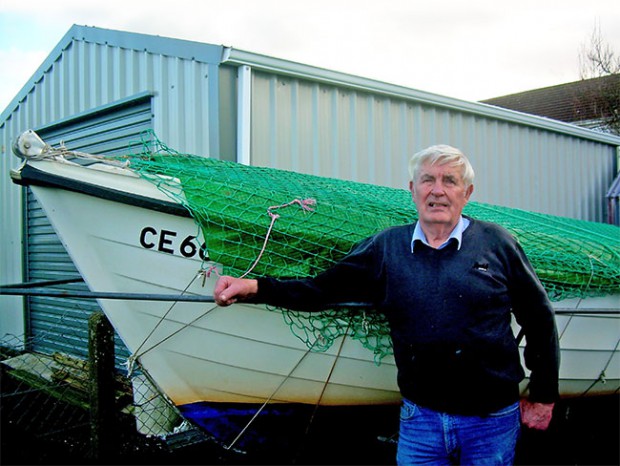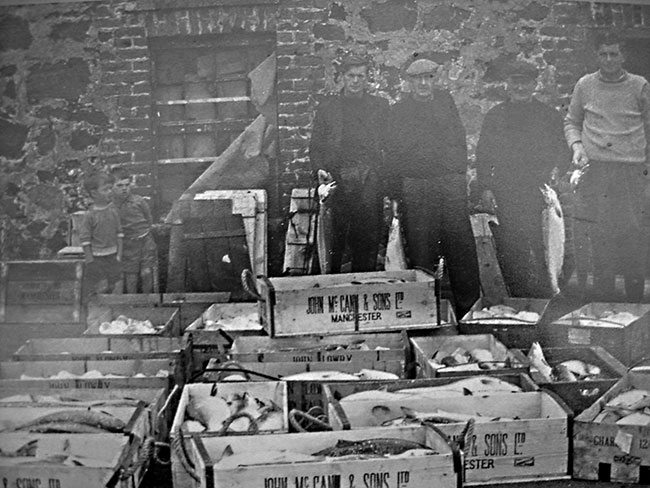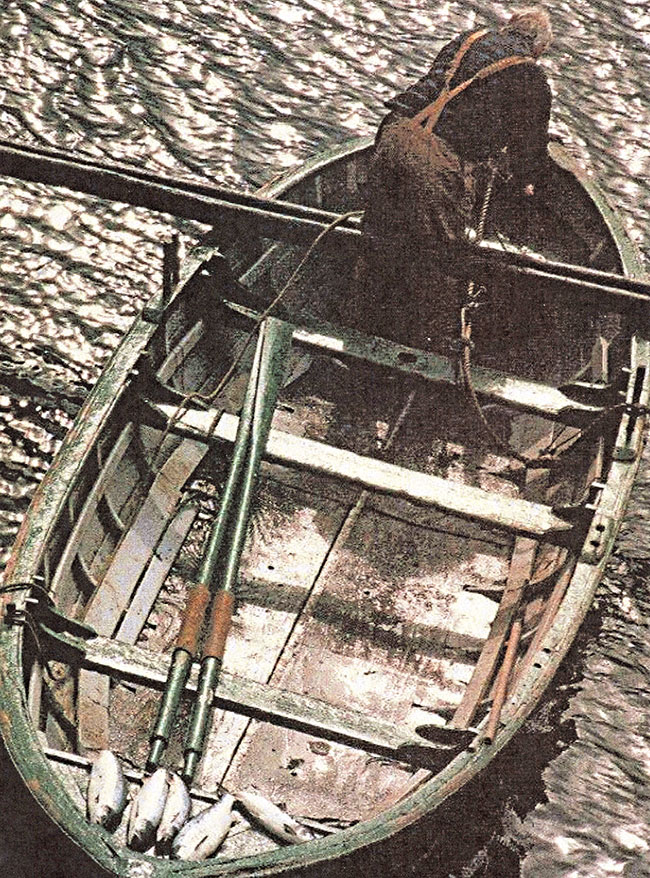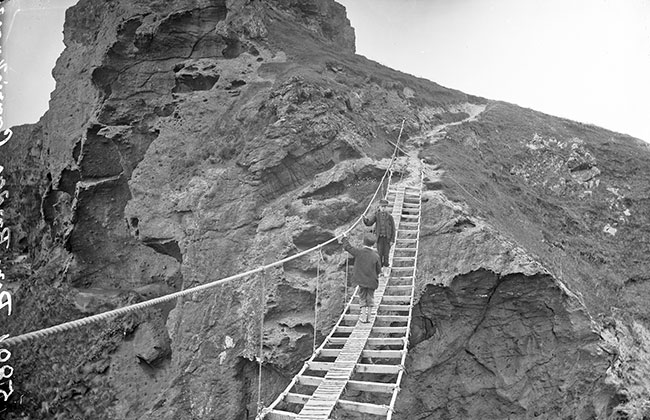5 January 2016 Edition
The Last Fisherman of Carrick-a-Rede
A story about the people who fished the salmon and the people who stole land and did deals with the English crown

• A ban on salmon fishing at sea ended 80-year-old Ackie Colgan of Ballintoy's lifetime of drift net fishing
Alexander ‘Ackie’ Colgan quit the fishery after a lifetime of drift net fishing when the authorities in Belfast decided that the declining Atlantic salmon needed a break
ACKIE COLGANof Ballintoy became the last fisherman of Carrick-a-Rede the day he took over from his uncle, Alex McNeill, in a boat that had seen better days. He was a young man in his mid-30s and fishing was in his blood. It was a natural progression and it should have continued for another 1,000 years, from one generation to the next. Instead, in September 2002 the boat was winched up from the sea onto the shore of the rock-island for the last time. After 31 years it was over.
And for once the lament has become a reality. Ackie Colgan is the last of his kind.
He turns 80 on 12 January. It has been a long road.
Suspended between ancient basalt, the rope-bridge across to Carrick-a-Rede was a practical solution to a pragmatic problem. The fishers of Ballintoy, the village below the headland, always knew the salmon returning to spawn in the Bush and Bann rivers ran past the rock-island. They just couldn’t get at them until sometime around the 1750s, when Alexander Stewart, the last in a 200-year line of colonial Stewarts on the north Antrim coast, provided the means. It is not known whether the fishermen liked the idea. The island was a dangerous place to fish from, in waters that were as treacherous as the times.
An iconic image within a generation of its appearances every spring and summer, hanging in the sky like an abrupt afterthought, the robe-bridge symbolised the romanticism of the causeway coast, attracting artists who produced paintings and sketches that idealised the reality. Thomas Mann Bayne’s 1831 faithful sketch shows the rope-bridge, the extent of the rocky island, the fishermen’s white-washed cottage, and the fishermen out on the sea, their drift net cast behind their small boat.
Alexander ‘Ackie’ Colgan quit the fishery after a lifetime of drift net fishing when the authorities in Belfast decided that the declining Atlantic salmon needed a break. Salmon fishing at sea was banned.

• The Mortons, pictured in 1962, sold Carrick-a-Rede salmon to John McCann & Sons in Manchester
Atlantic salmon stocks had gone into a dramatic decline the year after Ackie replaced his uncle Alex in the boat at Carrick-a-Rede. It was 1971. In the North of Ireland, the catch fell by one-third from 180,000 tonnes. By the the end of the 1970s, the catch was approximately 100,000 tonnes. In the early 1980s, the catch peaked at 185,000 tonnes and then began to fall gradually to below 20,000 tonnes in the early 2000s. The number of north Atlantic salmon at sea in the 1970s was around nine million – Now there are less than three million.
But this story is not really about salmon; it is about the people who fished the salmon and the people who stole land, did deals with the English crown, acquired the best land (and fishing areas) and began to rewrite history because they could not and did not want to understand the indigenous culture.
Greg Toner, Professor of Irish and Celtic at Queen’s University in Belfast (writing in the Gaelic language studies magazine Ainm) believes it was the first fishermen to use the rope-bridge in the 1750s who named the small rock-island. “The bridge must be as old as the name and so the name supports the claim in the Ordnance Survey memoirs that the erection of a rope-bridge on the island goes back to the 18th century. It also suggests that the fishermen who erected and used the bridge at this time were Irish-speaking.”
Ackie is not convinced.
“I don’t believe there was a bridge there before 1750,” he says. “All the rocks around here were named centuries ago. The popular name for it here was ‘The Rock of the Road’ but a lot of people said that was not right at all.”
Another clue comes from a 1630 document which listed the salmon fisheries from the Lagan to the Foyle. “There was a meeting at Carrickfergus in 1630 to value the salmon fisheries and Carrick-a-Rede wasn’t mentioned,” says Ackie knowingly.
It is his assertion that Carrick-a-Rede was one of the last places to be fished. In the early 1600s, fishers at Portstewart, Portrush, Portballintrae, Dunseverick, Port Braden, Port Moon, Larrybane, Ballycastle, Tor Head, Cushendun, Cushendall and Carnlough were granted licences to fish for salmon. “Larrybane was fished for a long time,” he says.

• Ackie on his boat off the coast of Carrick-a-Rede
Archibald Stewart, a descendant of James Stewart from the isle of Bute in western Scotland, was granted the district of Ballintoy by Randal MacDonnell, who had been given the title of the first Earl of Antrim. The grant included Sheep Island and all the other little islands around Ballintoy. MacDonnell kept for himself the salmon fishery of Portnalarabane (now Larrybane bay).
That was in 1625. Ackie is adamant that the little island that became known as Carrick-a-Rede would have had an Irish name, but there is nothing in the historical documents to indicate what it was. The tenants at that time were “Scotch”. The plantation of 1606, which robbed mosts of the original landowners of their property, left the area barren of native Irish-speakers. Ackie believes this is one explanation why the names of the islands and sea rocks are unknown today, because there was no one to pass them down to the next generation.
Following the rebellion of 1641 and the consequent years of conflict, the Stewarts used their power and wealth to increase the Ballintoy estate. A century later, in 1742, it contained 3,505 acres and yielded a modest rent but the Stewarts were in trouble. Alexander Stewart inherited a debt-ridden estate and decided he needed to produce some wealth from the land – and the sea.
Among his first acts was to establish a salmon fishery beyond the rock that towered as high as the cliff edge, east of Ballintoy village. He followed this by building a quay and opening a colliery, attracting grants from the Government. Then, inexplicably, in 1759 he sold the entire estate to a solicitor in Belfast, who in turn sold it for £20,000 to Alexander Fullerton, a doctor who had made his money in the West Indies and wanted to return to the Antrim coast.
The Ordnance Survey of the 1830s noted that the rope-bridge was established between the mainland and the rock-island “around 1750” but the name of the person who was responsible for this glorious act has been erased from the record. The fact that there was a name (probably an agent or foreman working on behalf of Alexander Stewart) is an indication that there is a record. That name has never been revealed.
Ackie remains nonplussed about the name of the rock-island and is less enamoured about its fame.
John Morton, whose father worked the fishery and sold the salmon to John McCann & Sons in Manchester (shipping it from Larne) admits that the tourist numbers were increasing in the 1960s and 1970s. Like Ackie, he is bemused today by the tens of thousands who come to walk across the ‘new’ bridge.
Ackie laughs. “When it rained the bridge was heavy and slippery, a devil to cross.”

• The rope-bridge across to Carrick-a-Rede pictured circa 1890
That last day in October 2002 was celebrated in a series of memorable photos by a local photographer but Ackie remembers well his first day out at Carrick-a-Rede when he was seven years old and many days after when he was “11 or 12”. It was the start of a romance. “I had been about Carrick-a-Rede, I helped out weekends, and I could have been at it from when I left school,” he says. “I am forever Ballintoy: my grandfather fished, my uncle fished; my mother, McCoy, was in one of the three fishermen’s cottages. In those days there was cod and haddock as well as salmon.”
The National Trust in England bought the rock-island from Derek Fullerton around 1970. A contract was drawn up with the fishermen and the Fisheries Conservatory Board handed out a licence. Ackie knew his place in this arrangement.
“The fishermen did what they were told. You could not catch a salmon; you could have ended up in jail. My grandfather, he was a fisherman all my life, my mother’s grandfather – the salmon would have been jumping thick and they not have dared catch one; they would have been arrested. The landed gentry controlled it, they claimed the rights to fish.
“There were a lot of places you could get salmon a lot easier than Carrick-a-Rede but you could catch more salmon at Carrick-a-Rede. It was about exploitation. Carrick-a-Rede is a difficult place to fish, it was a difficult place to get into a boat and get out of a boat. Nowadays you would not be allowed to fish like that.”
The sale of Carrick-a-Rede angered some of the local people and the irony of the sale to the National Trust is not lost on the people of Ballintoy. They made the rope-bridge with their own hands, erecting it in the spring and dismantling it in the autumn, they made the fishery with their sweat and they created the story. And they probably gave the rock-island its iconic name.
And they have good cause to celebrate the life of a man who will always be known as “The Last Fisherman of Carrick-a-Rede”.




